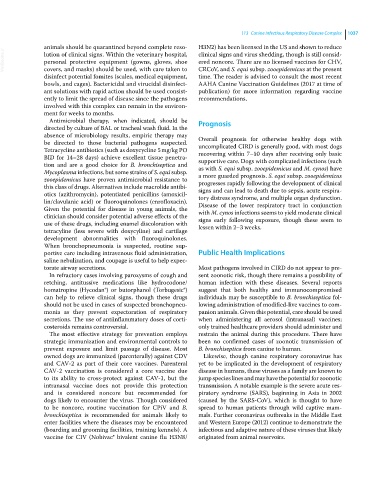Page 1099 - Clinical Small Animal Internal Medicine
P. 1099
113 Canine Infectious Respiratory Disease Complex 1037
animals should be quarantined beyond complete reso- H3N2) has been licensed in the US and shown to reduce
VetBooks.ir lution of clinical signs. Within the veterinary hospital, clinical signs and virus shedding, though is still consid-
ered noncore. There are no licensed vaccines for CHV,
personal protective equipment (gowns, gloves, shoe
covers, and masks) should be used, with care taken to
time. The reader is advised to consult the most recent
disinfect potential fomites (scales, medical equipment, CRCoV, and S. equi subsp. zooepidemicus at the present
bowls, and cages). Bactericidal and virucidal disinfect- AAHA Canine Vaccination Guidelines (2017 at time of
ant solutions with rapid action should be used consist- publication) for more information regarding vaccine
ently to limit the spread of disease since the pathogens recommendations.
involved with this complex can remain in the environ-
ment for weeks to months.
Antimicrobial therapy, when indicated, should be Prognosis
directed by culture of BAL or tracheal wash fluid. In the
absence of microbiology results, empiric therapy may Overall prognosis for otherwise healthy dogs with
be directed to those bacterial pathogens suspected. uncomplicated CIRD is generally good, with most dogs
Tetracycline antibiotics (such as doxycycline 5 mg/kg PO recovering within 7–10 days after receiving only basic
BID for 14–28 days) achieve excellent tissue penetra- supportive care. Dogs with complicated infections (such
tion and are a good choice for B. bronchiseptica and as with S. equi subsp. zooepidemicus and M. cynos) have
Mycoplasma infections, but some strains of S. equi subsp. a more guarded prognosis. S. equi subsp. zooepidemicus
zooepidemicus have proven antimicrobial resistance to progresses rapidly following the development of clinical
this class of drugs. Alternatives include macrolide antibi- signs and can lead to death due to sepsis, acute respira-
otics (azithromycin), potentiated penicillins (amoxicil- tory distress syndrome, and multiple organ dysfunction.
lin/clavulanic acid) or fluoroquinolones (enrofloxacin). Disease of the lower respiratory tract in conjunction
Given the potential for disease in young animals, the with M. cynos infections seems to yield moderate clinical
clinician should consider potential adverse effects of the signs early following exposure, though these seem to
use of these drugs, including enamel discoloration with lessen within 2–3 weeks.
tetracyline (less severe with doxycyline) and cartilage
development abnormalities with fluoroquinolones.
When bronchopneumonia is suspected, routine sup-
portive care including intravenous fluid administration, Public Health Implications
saline nebulization, and coupage is useful to help expec-
torate airway secretions. Most pathogens involved in CIRD do not appear to pre-
In refractory cases involving paroxysms of cough and sent zoonotic risk, though there remains a possibility of
retching, antitussive medications like hydrocodone/ human infection with these diseases. Several reports
homatropine (Hycodan®) or butorphanol (Torbugesic®) suggest that both healthy and immunocompromised
can help to relieve clinical signs, though these drugs individuals may be susceptible to B. bronchiseptica fol-
should not be used in cases of suspected bronchopneu- lowing administration of modified‐live vaccines to com-
monia as they prevent expectoration of respiratory panion animals. Given this potential, care should be used
secretions. The use of antiinflammatory doses of corti- when administering all aerosol (intranasal) vaccines;
costeroids remains controversial. only trained healthcare providers should administer and
The most effective strategy for prevention employs restrain the animal during this procedure. There have
strategic immunization and environmental controls to been no confirmed cases of zoonotic transmission of
prevent exposure and limit passage of disease. Most B. bronchiseptica from canine to human.
owned dogs are immunized (parenterally) against CDV Likewise, though canine respiratory coronavirus has
and CAV‐2 as part of their core vaccines. Parenteral yet to be implicated in the development of respiratory
CAV‐2 vaccination is considered a core vaccine due disease in humans, these viruses as a family are known to
to its ability to cross‐protect against CAV‐1, but the jump species lines and may have the potential for zoonotic
intranasal vaccine does not provide this protection transmission. A notable example is the severe acute res-
and is considered noncore but recommended for piratory syndrome (SARS), beginning in Asia in 2002
dogs likely to encounter the virus. Though considered (caused by the SARS‐CoV), which is thought to have
to be noncore, routine vaccination for CPiV and B. spread to human patients through wild captive mam-
bronchiseptica is recommended for animals likely to mals. Further coronavirus outbreaks in the Middle East
enter facilities where the diseases may be encountered and Western Europe (2012) continue to demonstrate the
(boarding and grooming facilities, training kennels). A infectious and adaptive nature of these viruses that likely
vaccine for CIV (Nobivac® bivalent canine flu H3N8/ originated from animal reservoirs.

